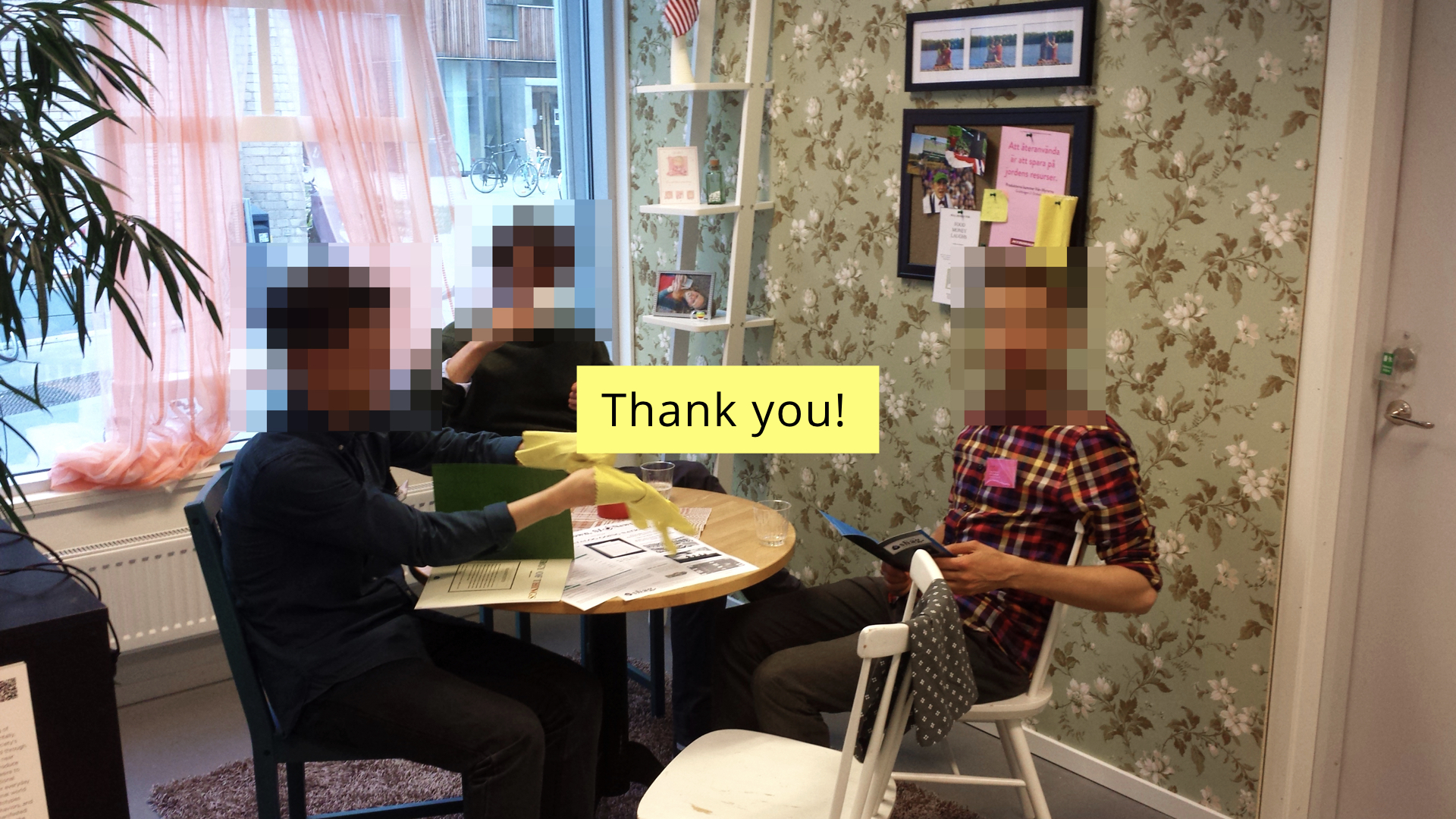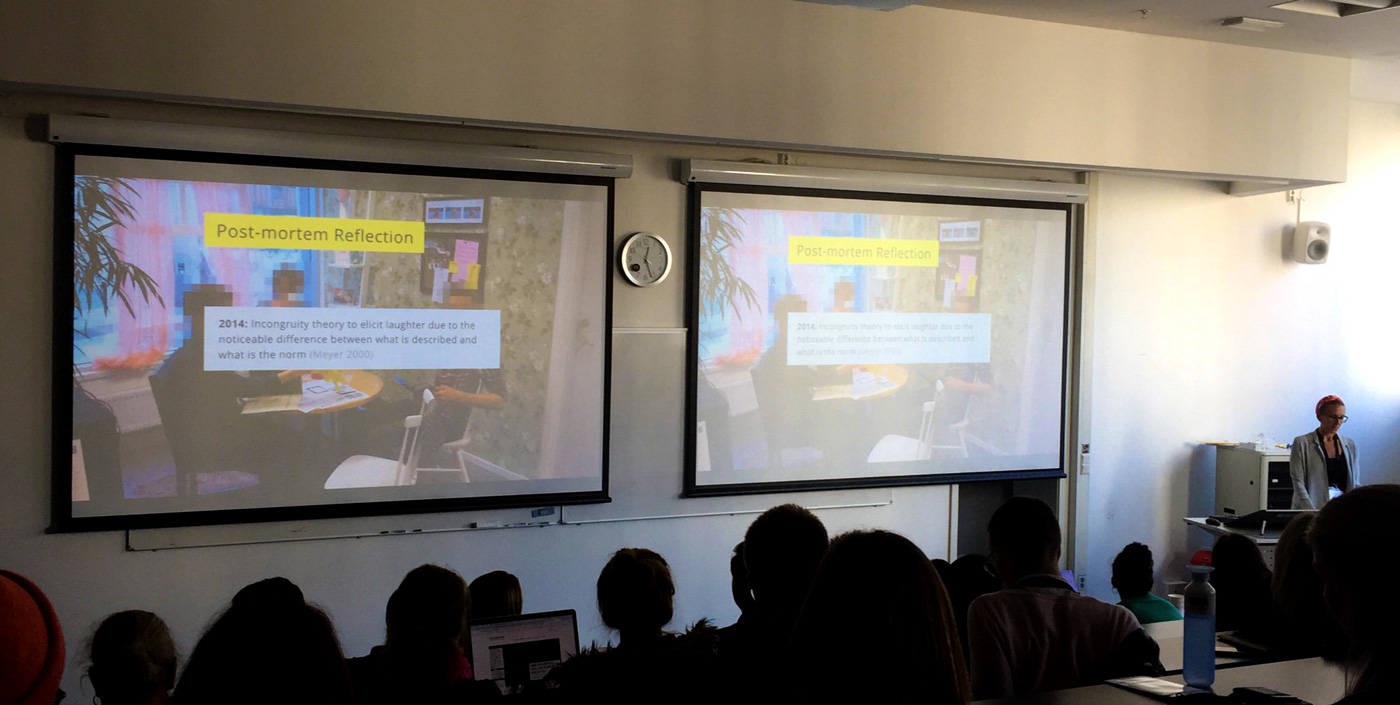
Early this week I presented a paper written with my PhD supervisor Ylva Fernaeus on the use of Humor in Design Fiction to Suspend Disbelief and Belief at NordiCHI 2018 in Oslo. This paper was part of the future scenarios track at NordiCHI, an excellent initiative and venue that explores the design of design fictions. Our paper contributed (1) a way in which humor might be used in design fiction (and design more broadly), (2) a design process that includes fieldwork to inform the design of design fictions, (3) and a human-scale design fiction as a method of communication and dissemination. For the presentation, I originally intended to role-play the paper presentation as a character from the fictional world, as I did when presenting the same project four years ago in Umeå as my master’s thesis, but last minute opted to not because of the opening introductions by moderators. Instead, I opened the presentation by jumping into the fiction with no context, and then gradually introduced more information and built reflections throughout the remaining of the presentation. I think this structure worked very well. The full paper is available here and the presentation below.
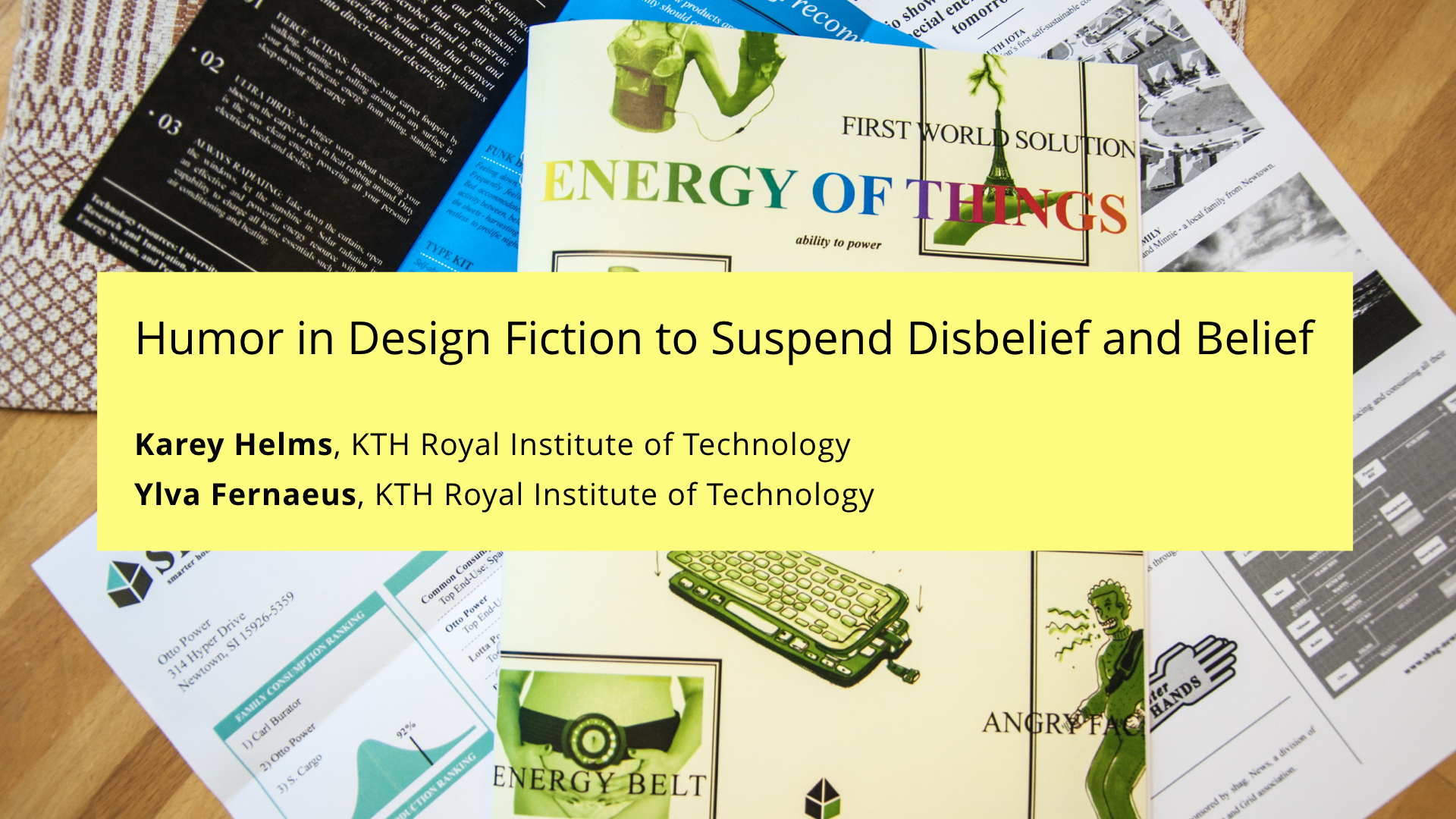
Before beginning this presentation, it is important note that the design fiction presented in this paper was originally designed in 2014 as my master’s thesis at Umeå Institute of Design, and is set four years later in 2018. Making the near-future the now present-day. And central to the design fiction is the Energy of Things catalog, a promotion and access resource tool of energy harvesting products and solutions to facilitate an energy self-sufficient lifestyle.
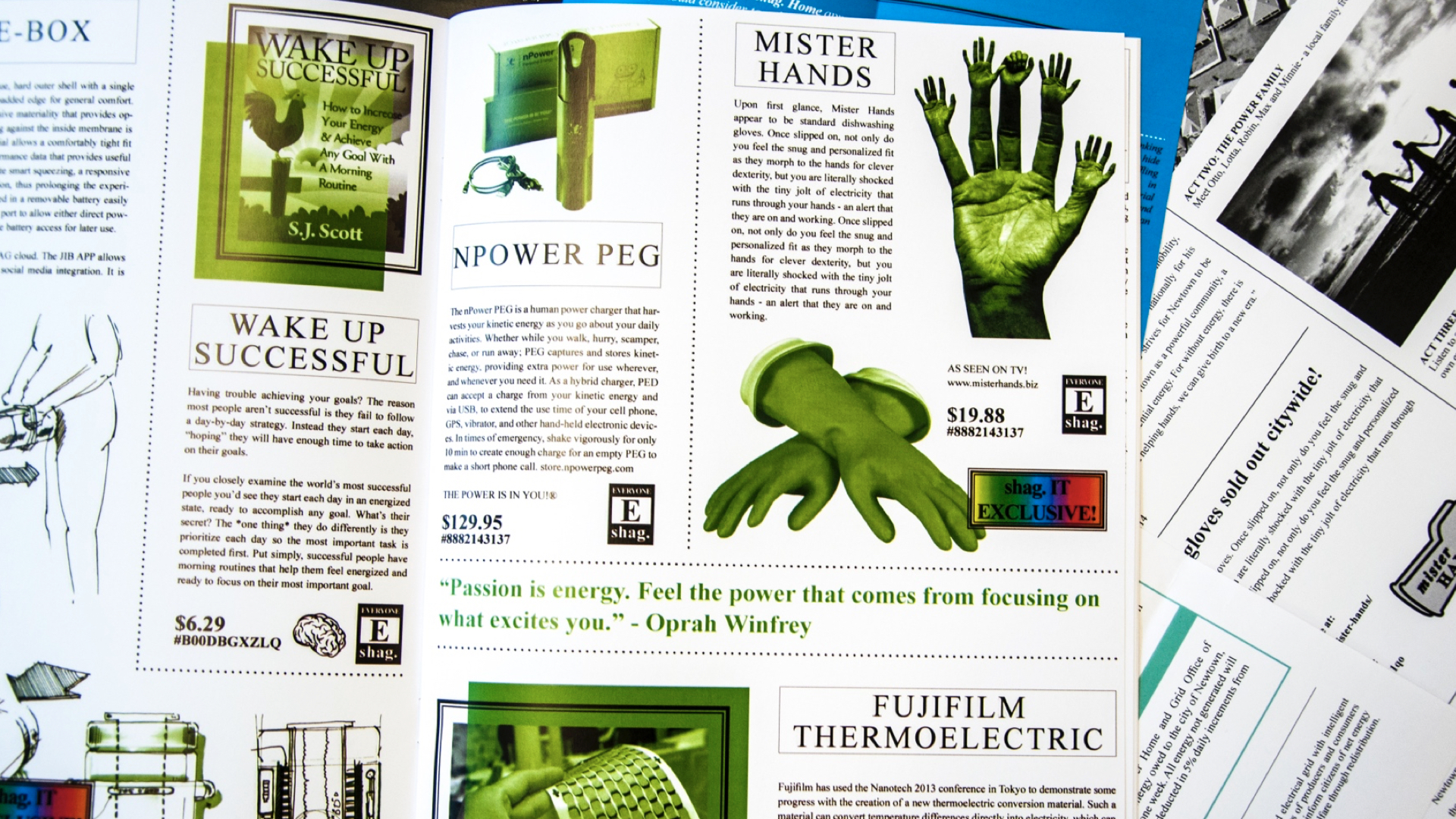
The catalog features products for purchase, such as Mister Hands, the all-in-one housewife helper that makes it easy to wash, scrub, and polish while generating electricity in minutes.
VIDEO
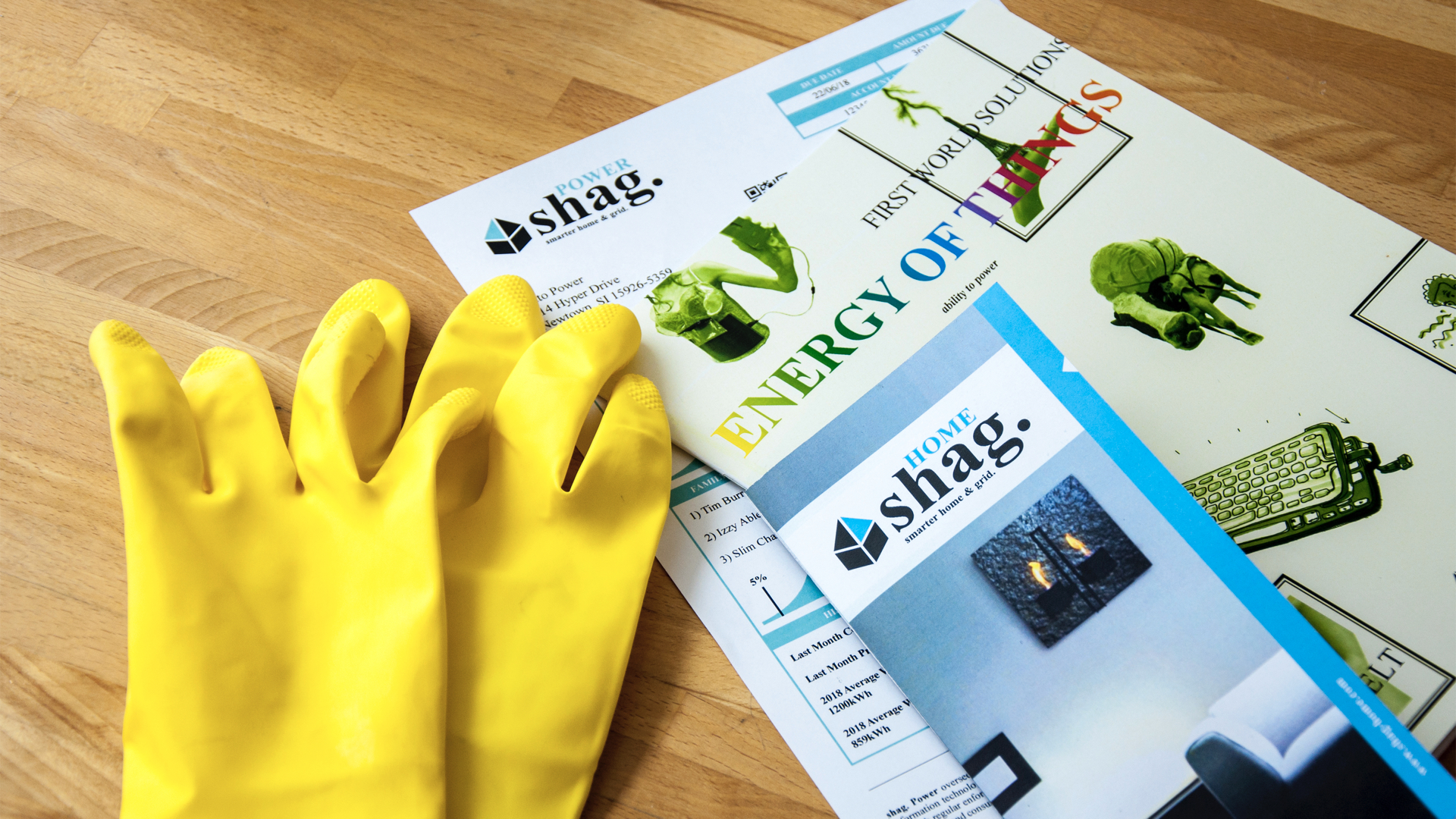
Mister Hands, the accompanying uncomfortable behaviors, and the solutions promoted by the Energy of Things catalog are actually only a hint of the promotional material providing information, motivation, and resources received in the mail by residents of the American town of Newtown, South Iota.
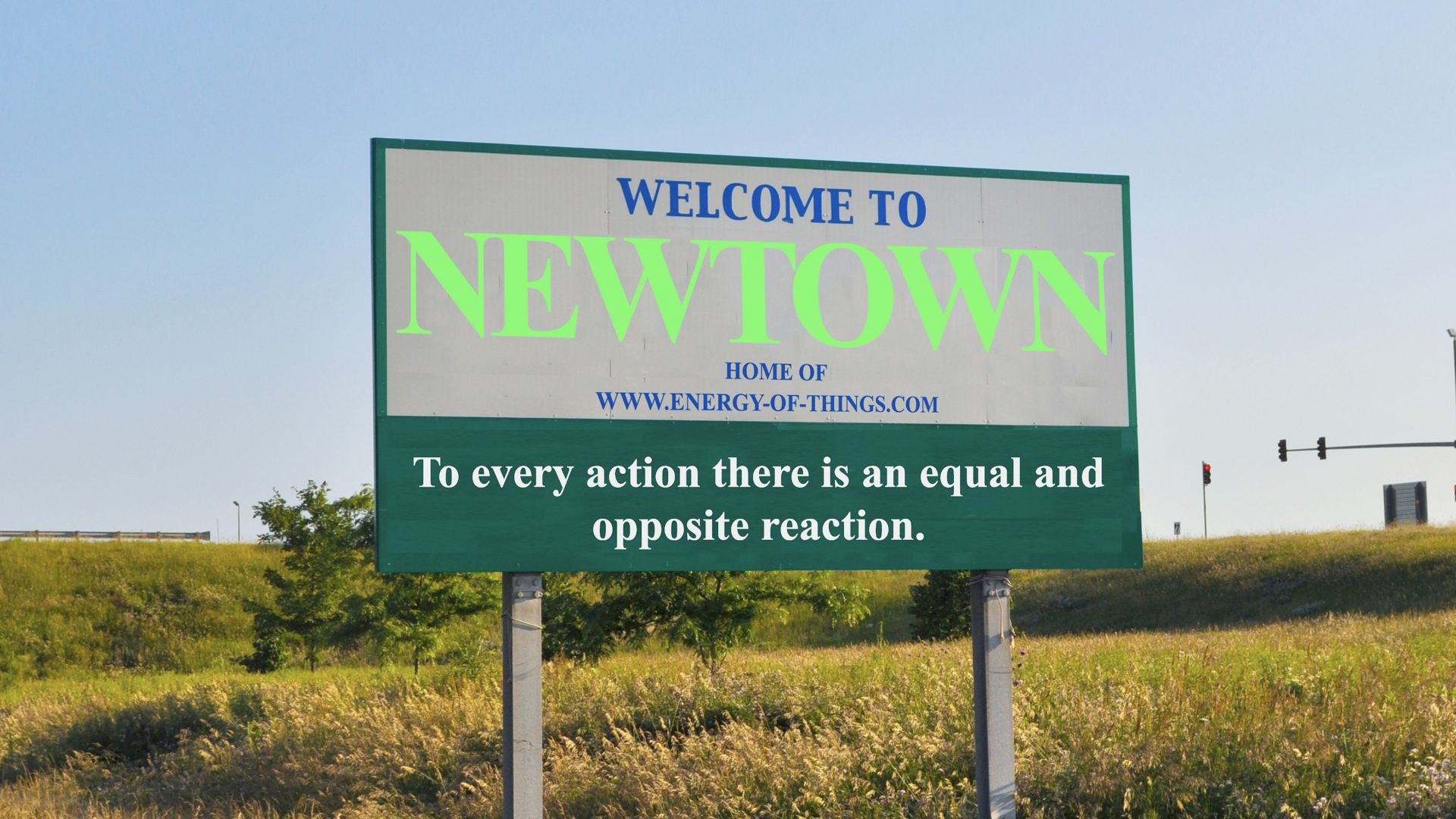
Newtown is a sustainable test city where all citizens are required to produce all the electrical energy they need or desire to consume – switching a focus from developing every source of American-made energy on to sourcing every energy made by Americans.
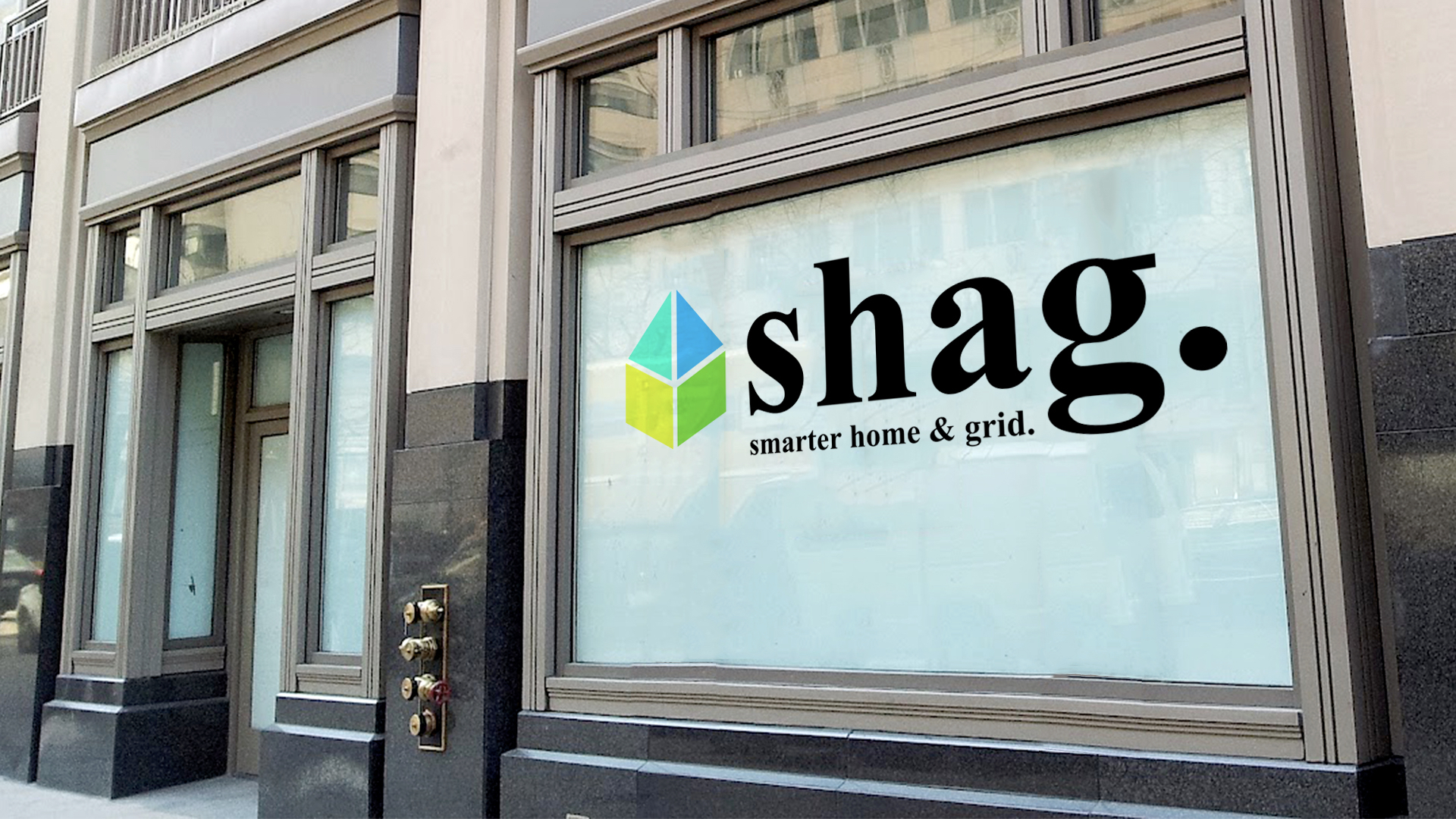
Newtown was established under the banner of the New Suburbanism design movement, and is administered by Smarter Home and Grid Association, or SHAG. SHAG follows the guiding principles of environmentalism, smart city growth, and intelligent home automation, placing an unprecedented focus on a return to the American Dream of social mobility through hard work.
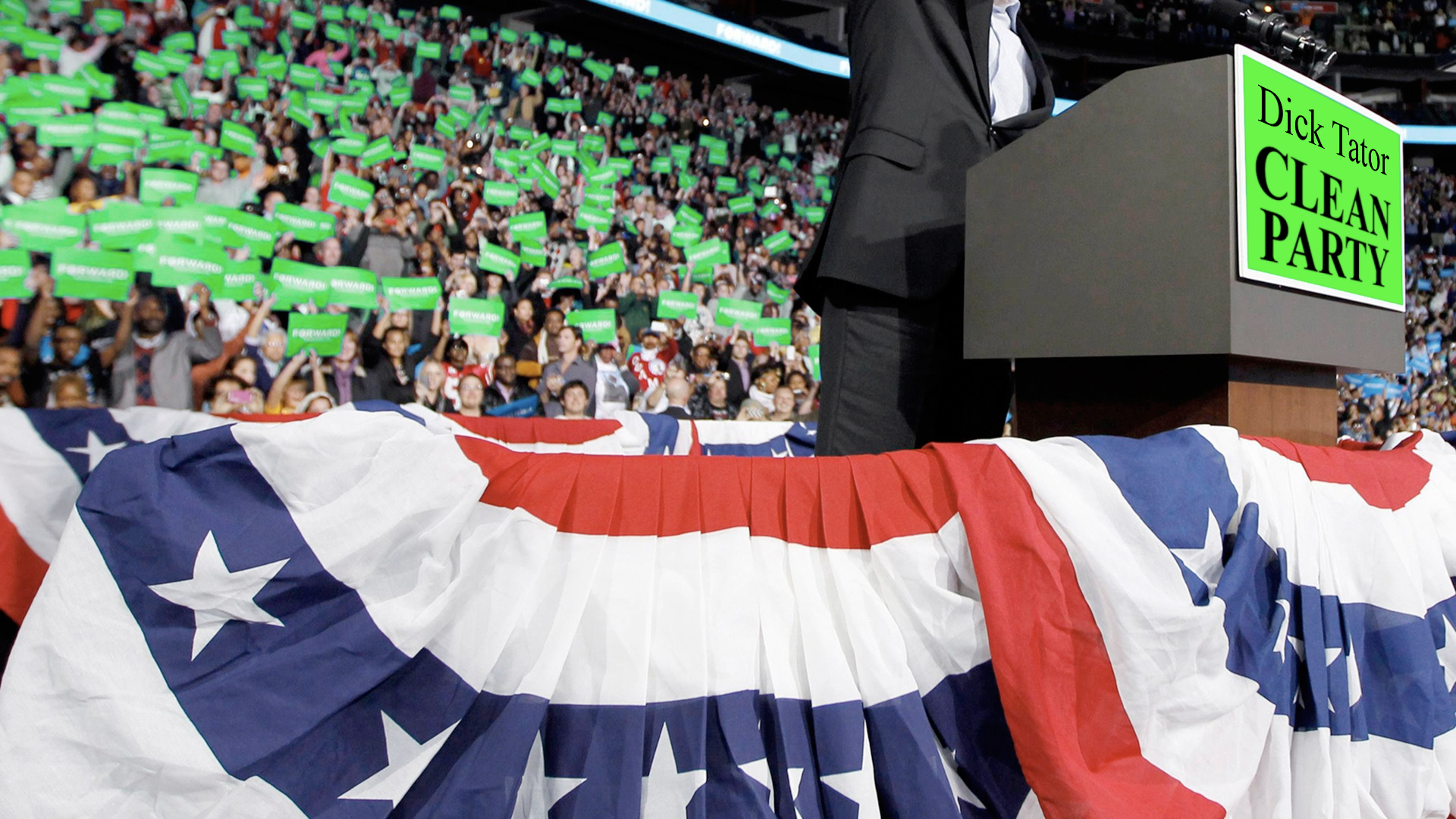
The town is governed by former senator Dick Tator, who was appointed to run Newtown after the Clean Party’s surge to power in the 2016 electrons. After the declaration of climate change as fact, which was definitely an inconvenient truth, public opinion was no doubt jolted in waves of alternating currents. This extreme polarity and variable resistance could only be bridged by the Clean Party, with their None-of-the-Above energy policy that advocated all energy in America to be made by Americans. Literally.

And thus, within this new world of energy production and consumption, the design fiction presented in this paper, invites you into a day in the life of the Power family of five, residents of Newtown, to experience the potential implications of this self-sustainable lifestyle, and ask: What if you were required to produce all the energy you desire to consume?
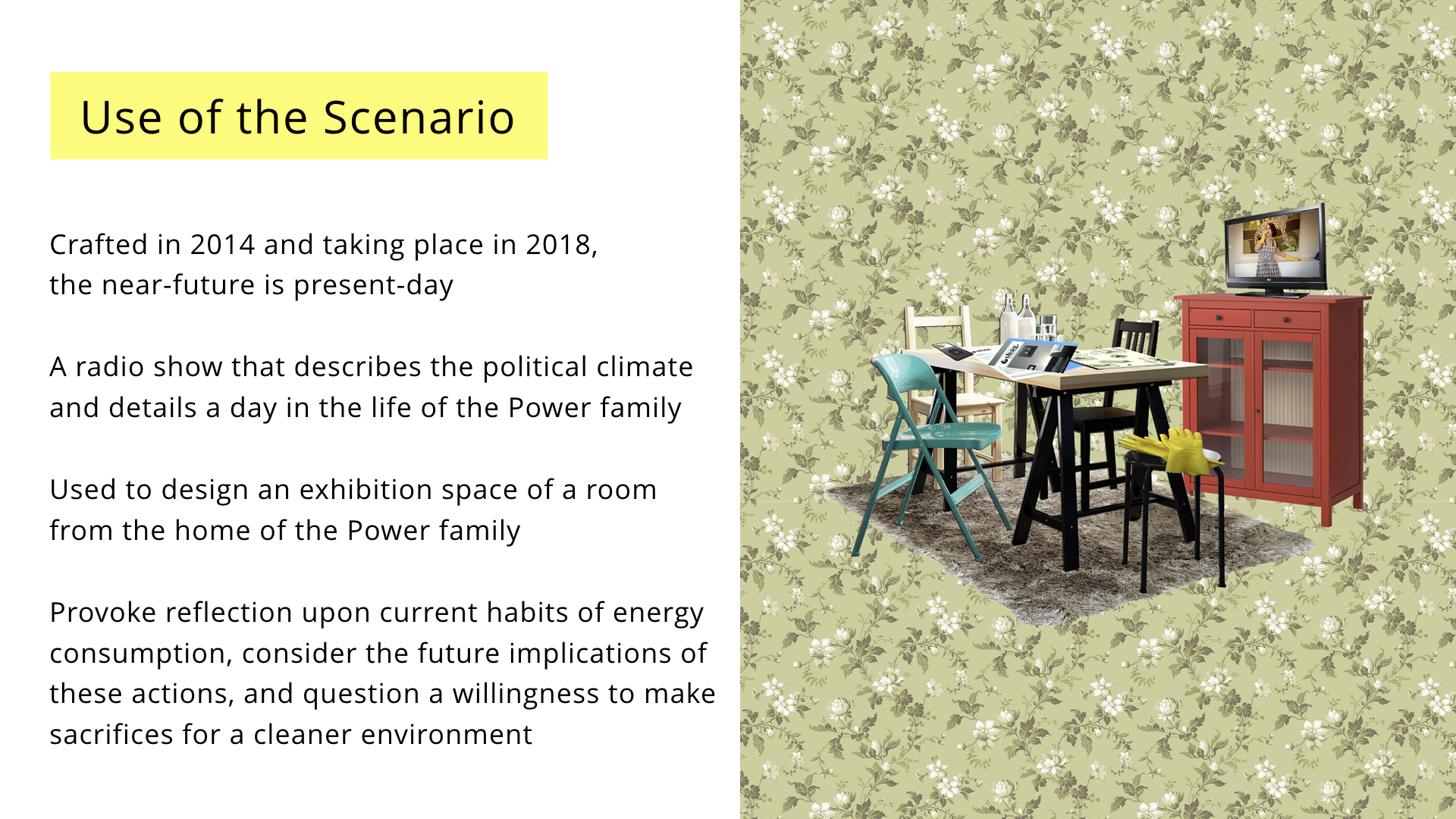
This scenario, crafted in 2014 and taking place four years later in 2018 – makes the near-future now present-day – and is part of a much larger narrative in the form of a twenty-minute radio show that parodies the public broadcast program This American Life.
The radio show both describes the political climate and corresponding sustainability programs in the United States pivoting upon the 2016 presidential election – while also giving a hyper-local perspective by detailing a day in the life of Power family who live in the fictional town Newtown.
The narrative was used to design an exhibition space of a room from the home of the Power family. And while the radio show was accessible through headphones, the dispersing of fictional artifacts from this world – such as the energy of things catalog and mister hands gloves and infomercial, among others – encouraged a stumbling upon and gradual perusing of details to provoke individuals to reflect upon their current habits of energy consumption, consider the future implications of these actions, and question a willingness to make sacrifices for a cleaner environment.
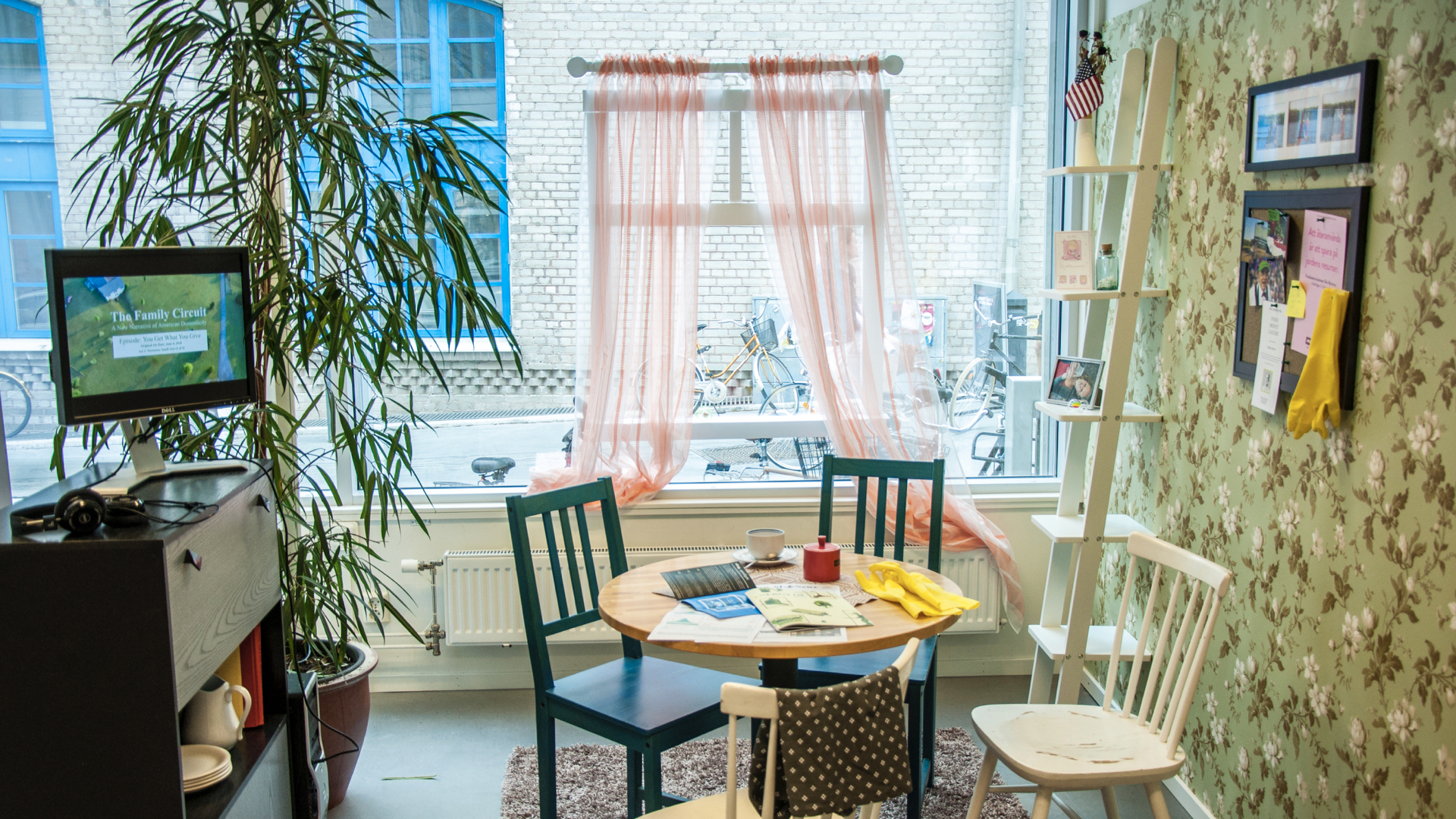
The room was exhibited for two weeks at Umeå Institute of Design, during an undergraduate degree show and an academic research conference (DRS 2014) – during which visitors included students, practitioners, design researchers, and the general public.
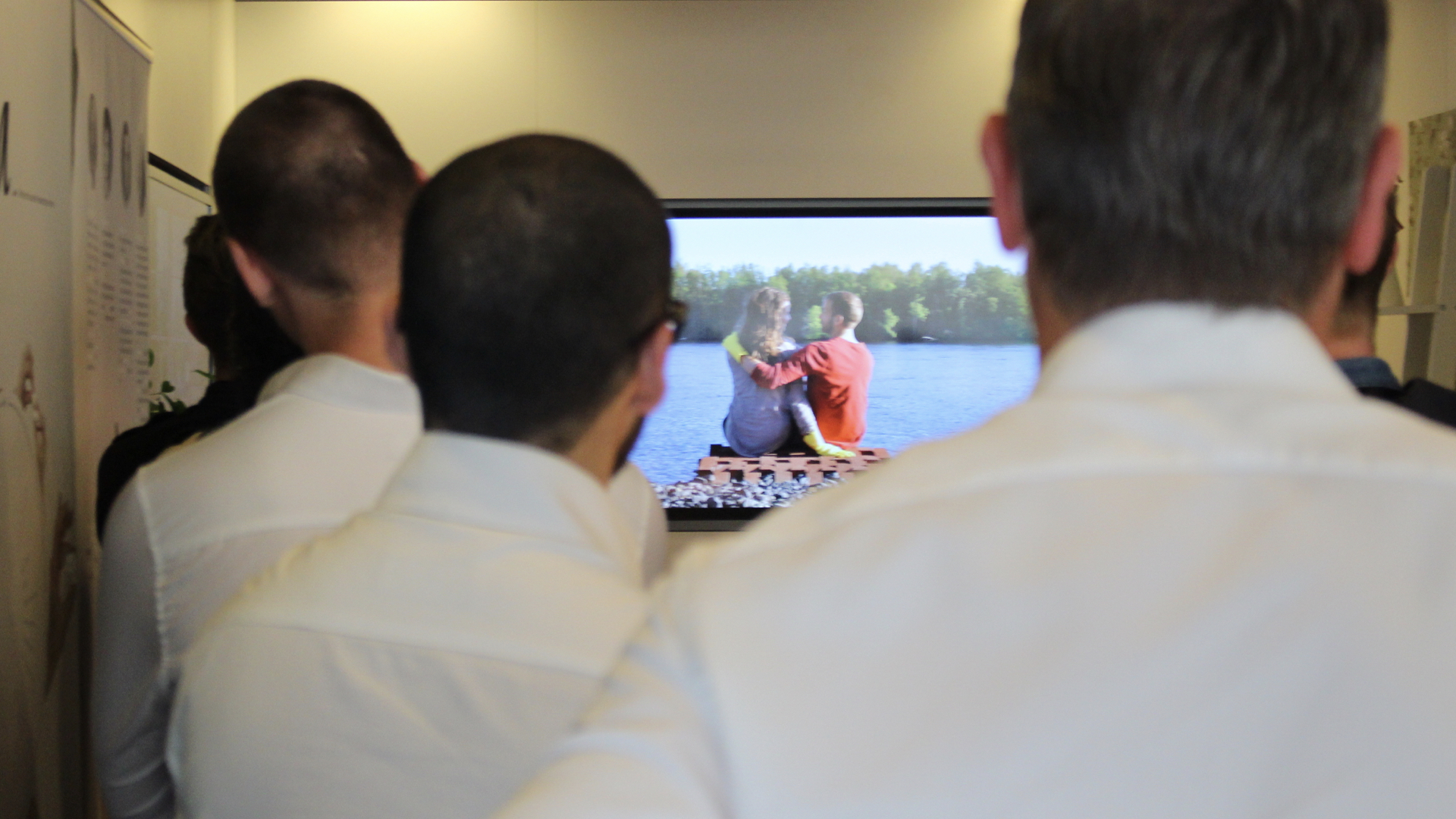
It was also exhibited at a private industry event at a technology corporation in Gothenburg that collaborates with automotive, manufacturing, and telecom sectors.
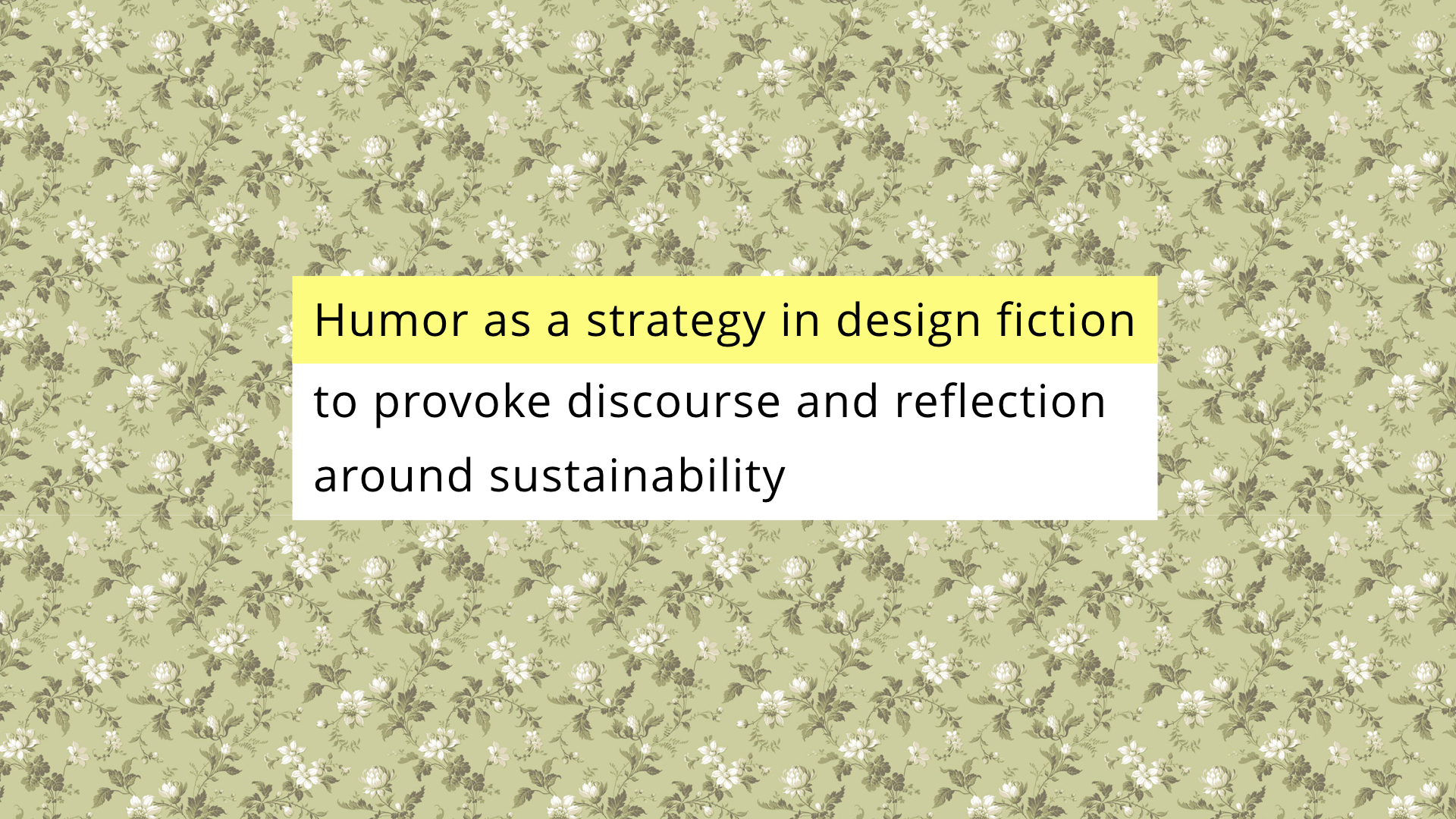
But while this design work is situated within the domestic context of sustainable HCI, this particular paper was driven by an investigation of humor as a resource and strategy in design fiction with the intention to provoke discourse and reflection around sustainability. And why investigate humor? Why might humor be interesting for HCI, or more specifically for design researchers in HCI?
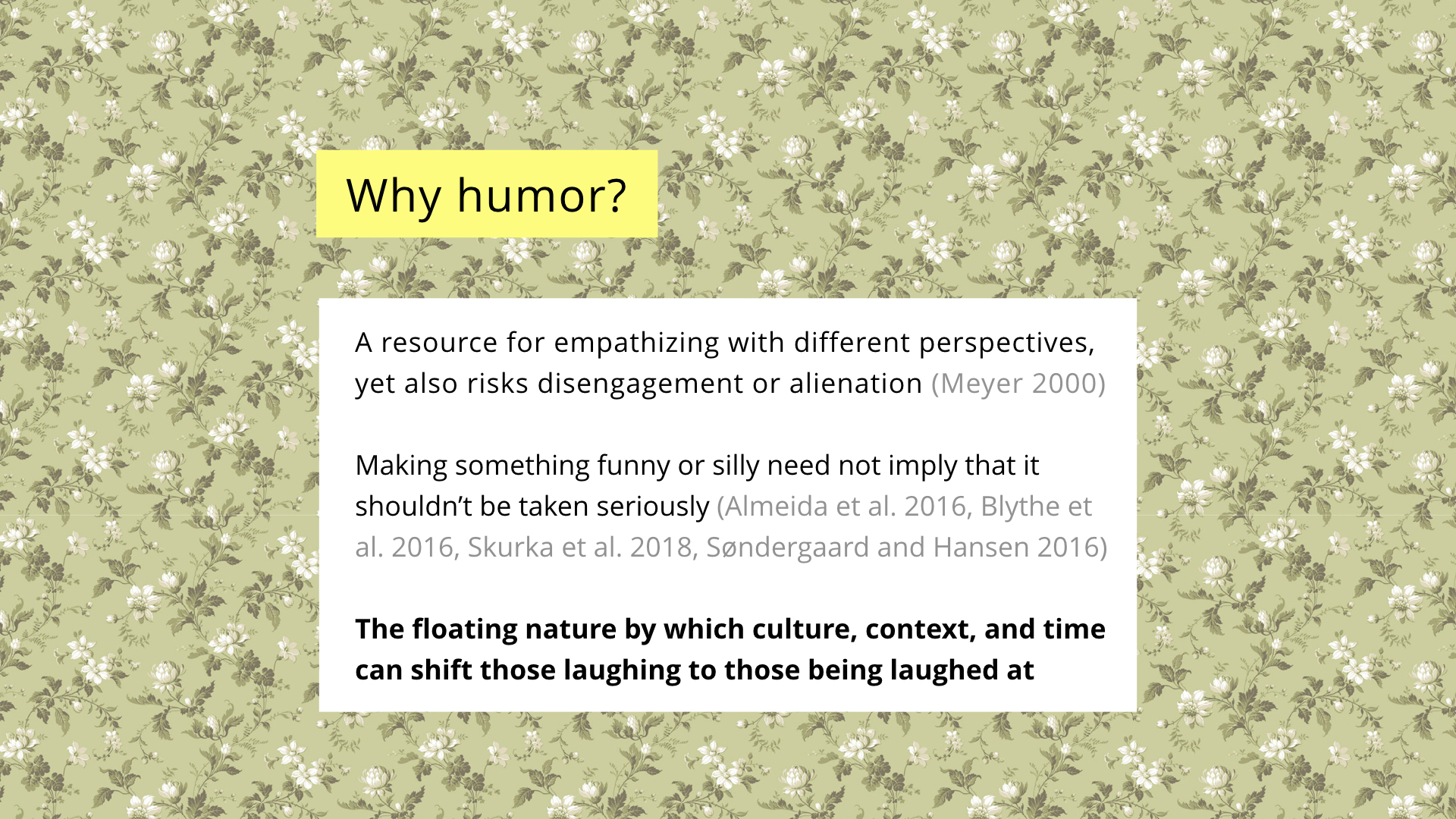
Humor is often considered a resource in understanding or empathizing with different perspectives, yet also risks disengagement or alienation, I would argue that this concern is particularly salient in HCI within Research through Design, a community drawing upon the participatory nature of design in which building empathy and trust are essential (as we’ve seen in many projects presented throughout the conference), and in which academic results should be rigorously communicated without further need of interpretation.
Yet, making something funny or silly need not imply that it shouldn’t be taken seriously. And this is seen in design methods such as anti-solutionist strategies, research on humor in societal and political communication, and in the engagement of taboo topics, such as women’s health, in which humor can also be a strategy for approachability and dialogue.
But when drawing upon humor as a narrative resource and intended outcome within design fiction, it is still unclear and under investigated how designers might attend to its structure and flow with additional consideration to the floating nature by which culture, context, and time can quickly shift those laughing to those being laughed at.
But also what is design fiction? And why might humor be an appropriate resource?
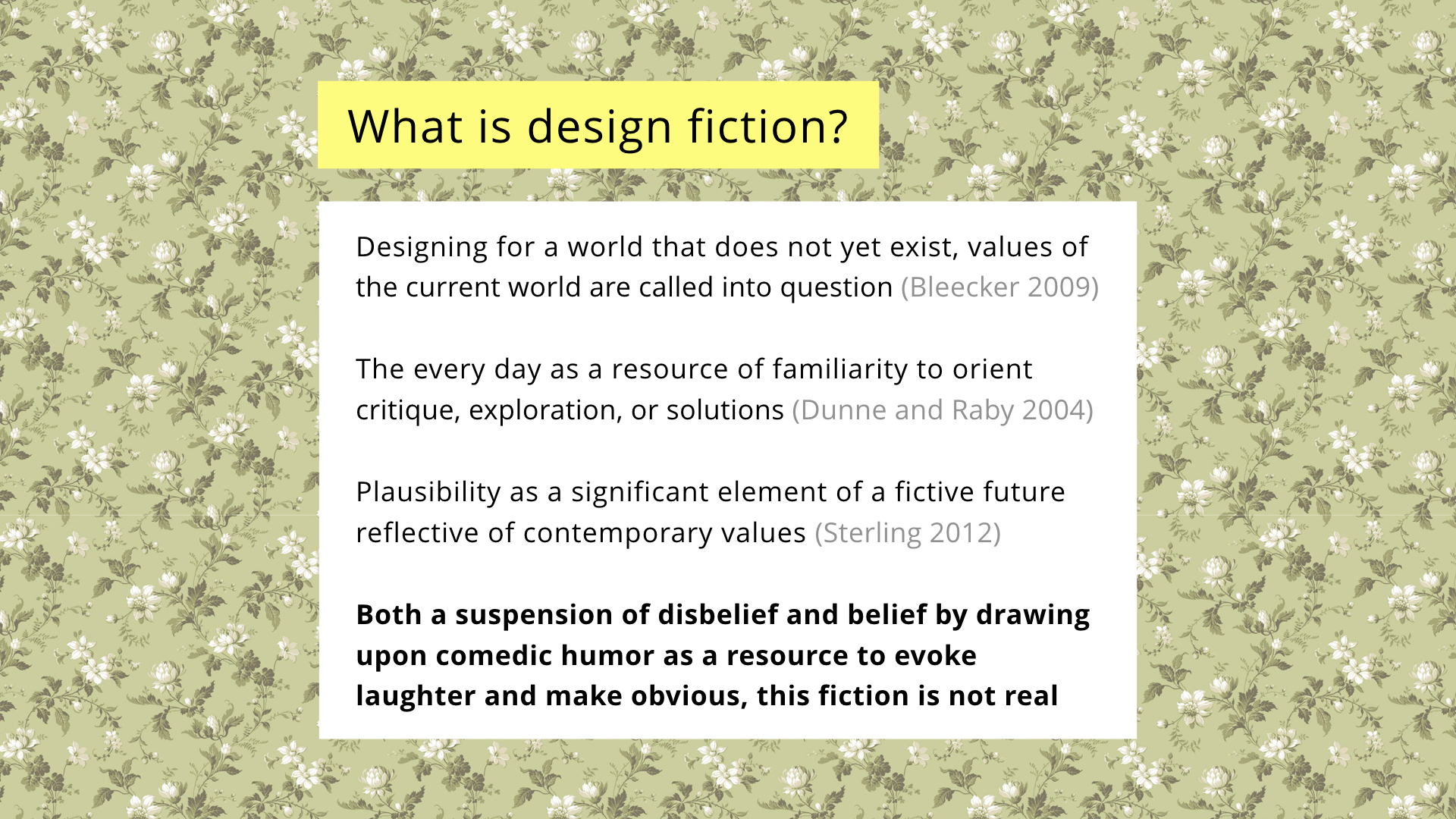
Design more broadly, is widely regarded as a future oriented practice with many methods, that though grounded in real user data, employ elements of fiction – such as personas, user stories, and scenarios. And Design fiction as a method largely differs from these in that it opens opportunities to consider not only what could be, but also what should be, through as said by Julian Bleecker “material objects that help tell stories about the future”. Embedded within this speculative tone is a reciprocal informing of the real and the imagined, or the present and the future, in which by designing for a world that does not yet exist, values of the current world are called into question.
This implied critique can be seen to position design fiction towards critical or speculative design practices, which invite reflection and discourse by calling into question the status quo through satire. But also similar to speculative practices, design fiction shares an alliance with the every day as a resource of familiarity from which fictional design artifacts can orient critique, exploration, or solutions.
These fictional design artifacts of design fiction are referred to as diegetic prototypes, or seemingly everyday objects that only exist within a fictional world – making use of a narrative to contextualize them, but also in turn functioning as plot devices that reveal tension, motivate drama, and ignite new behaviors that suggest broad implications of technology in everyday practice – such as Mister Hands. As described by Bruce Sterling, design fiction is ultimately “the deliberate use of diegetic prototypes to suspend disbelief about change”, foregrounding plausibility as a significant element of a fictive future reflective of contemporary values.
Yet, other researchers have expressed concern over plausibility, calling design fiction deceptive and thus challenging research ethics. This concern is similar echoed in what Lars Erik Holmquist calls cargo cult design, in which artifacts of the design process are mistaken for real representations of a future state.
Thus, rather than aiming exclusively for plausibility, the design fiction in this paper investigates the possibility of both a suspension of disbelief and belief by drawing upon comedic humor as a resource to evoke laughter and amusement and make obvious, this fiction is not real.
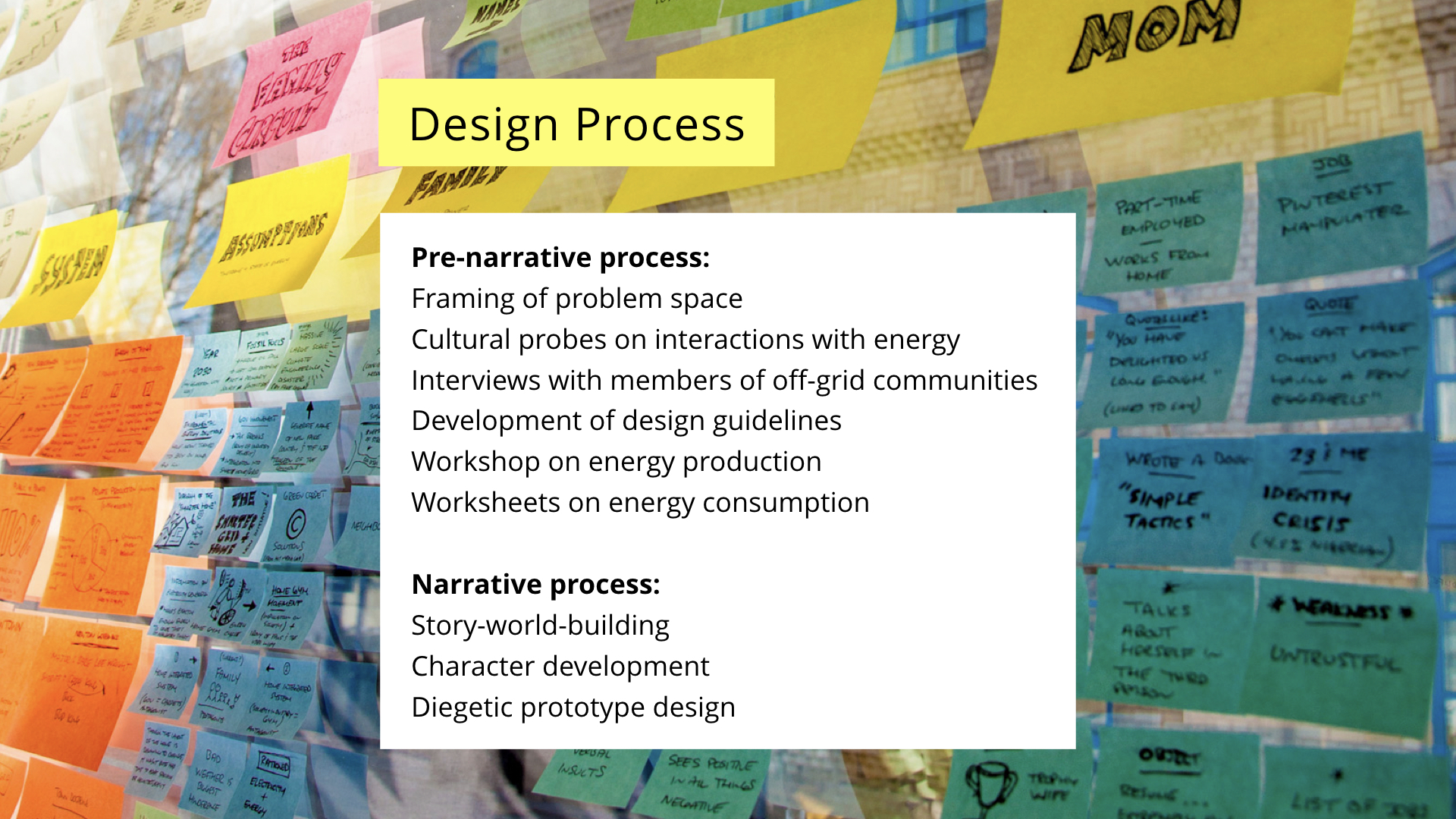
So while I don’t have time time to go through the entire design process of how I both used and crafted humor to suspend disbelief and belief in the design fiction – most often in the form of puns, parody, and pastiche – the design process is detailed in the paper.
And instead I will briefly describe three deliberate attempts at humor – before presenting reflections and lessons learned on using humor.
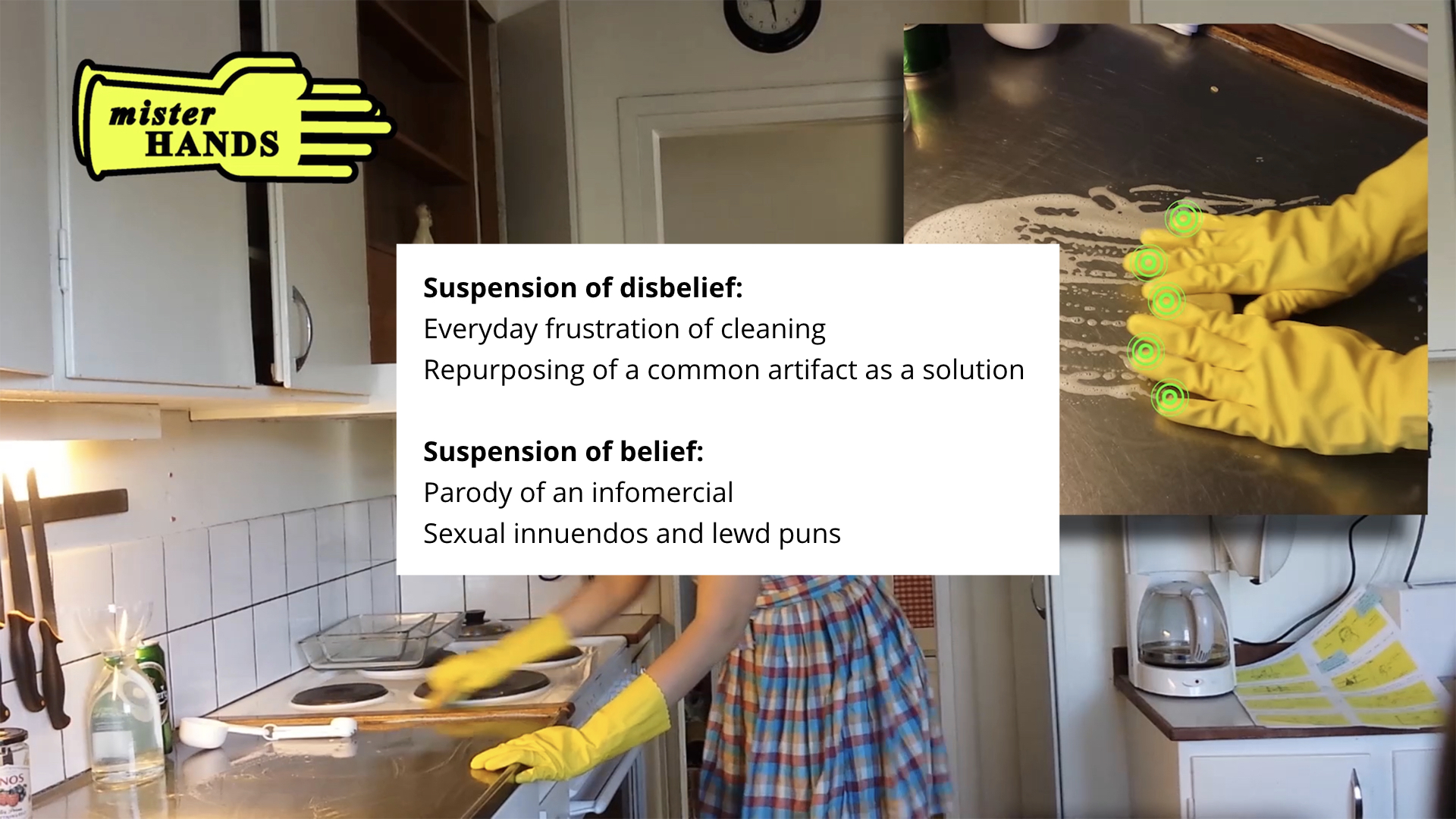
Returning to the Mister Hands infomercial, for a suspension of disbelief – this advertisement for an energy harvesting product sensationalizes the everyday frustration of cleaning and repurposes a ubiquitous article as an innovative solution. It is a parody – or a deliberate exaggeration for comic effect – of an infomercial with factual details that might obscure an implicit point-of-view. For a suspension of belief, this point-of-view is made obvious through sexual innuendos and lewd puns to explicitly critique labor-saving messages and housewife portrayals evident in the history of advertisements for electrical appliances. Beyond how this product might change the experience of cleaning, the sexual subtext hints how intimate relationships might also be affected with such energy harvesting devices.
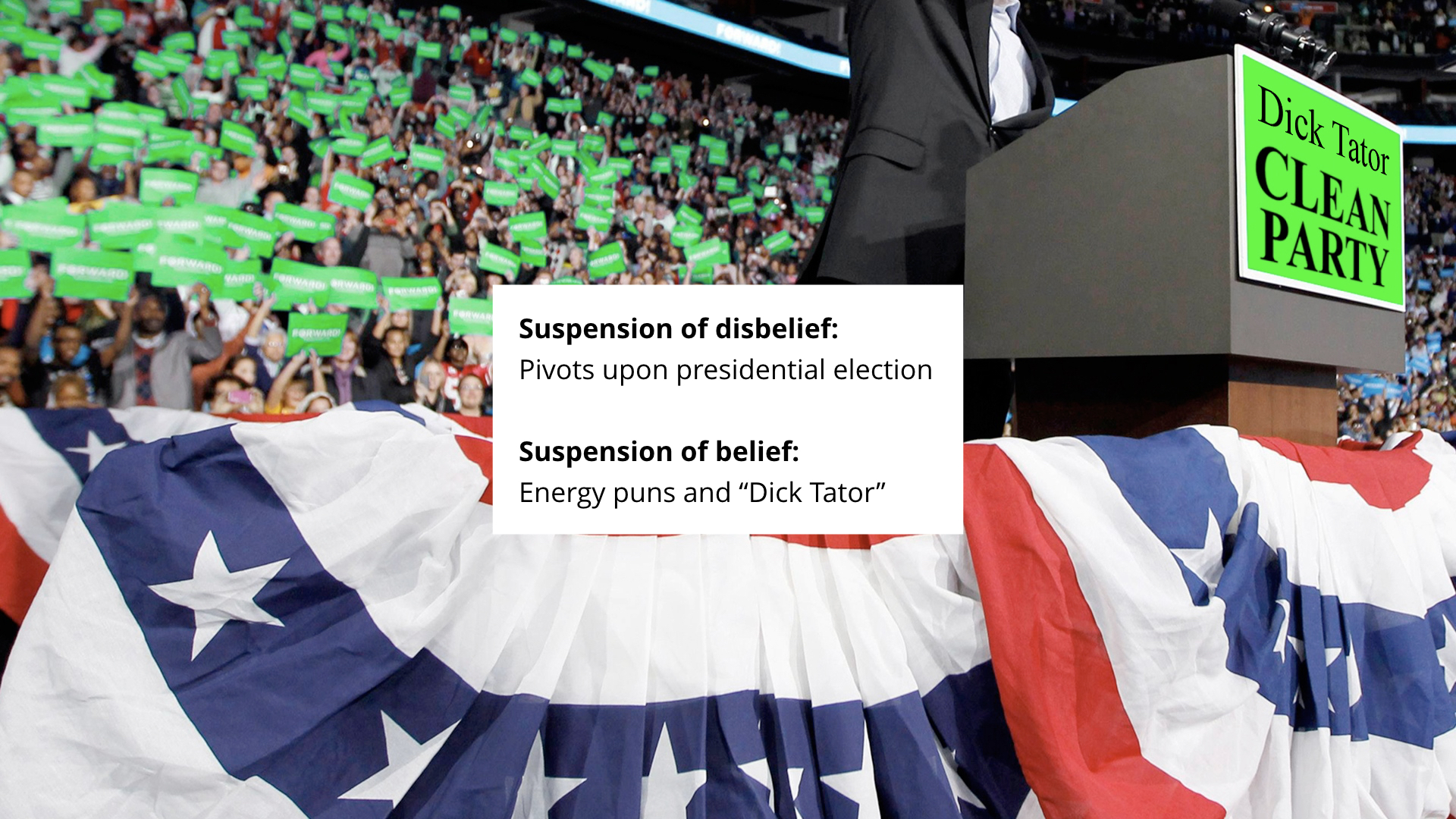
Another example from earlier can be seen in the description of the political climate. For a suspension of disbelief – or to make this near-future believable – the government is situated only four years into the future and pivots upon presidential election to make drastic legislation attainable. For a suspension of belief – an overload of energy puns – and the pun “Dick Tator” – was employed to make obvious the fictive nature of the narrative, and to also elicit laughter as a tactic to make broader and often polarizing socioeconomic topics accessible rather than didactic.
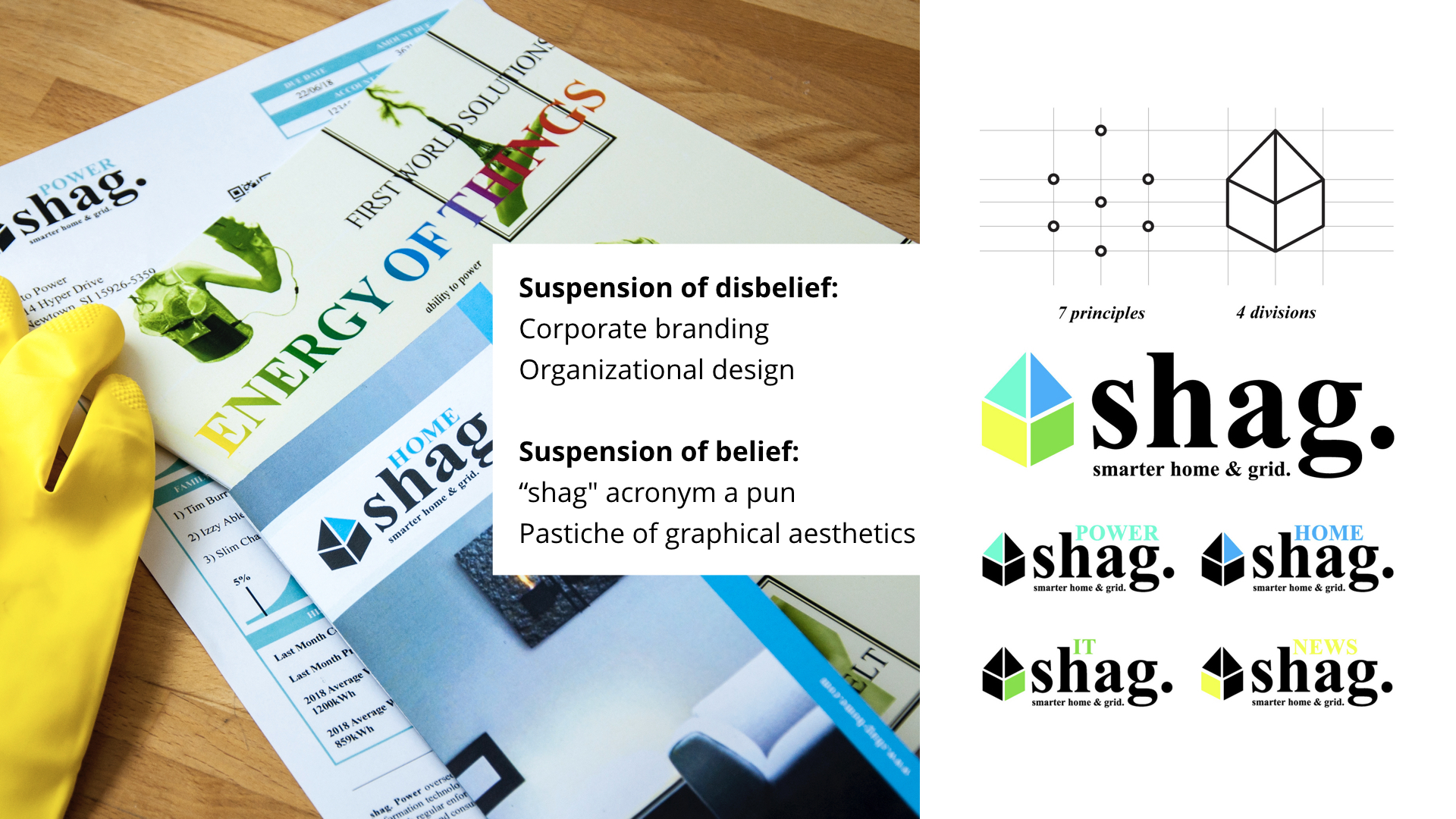
A third example is in the graphical aesthetics. For a suspension of disbelief, an identity design was created for Smarter Home and Grid, including its sub-organizations indicative of large institutions for a believable experience of government artifacts. And for a suspension of belief, shag is a sexual pun, but also the graphic design of artifacts – including the infomercial and catalog – are a pastiche, or a medley of artistic imitations that parodies the counterculture ethos of Whole Earth Catalog and the whimsical items of Sky Mall – to reduce the risk of misinterpreting the materials as real.
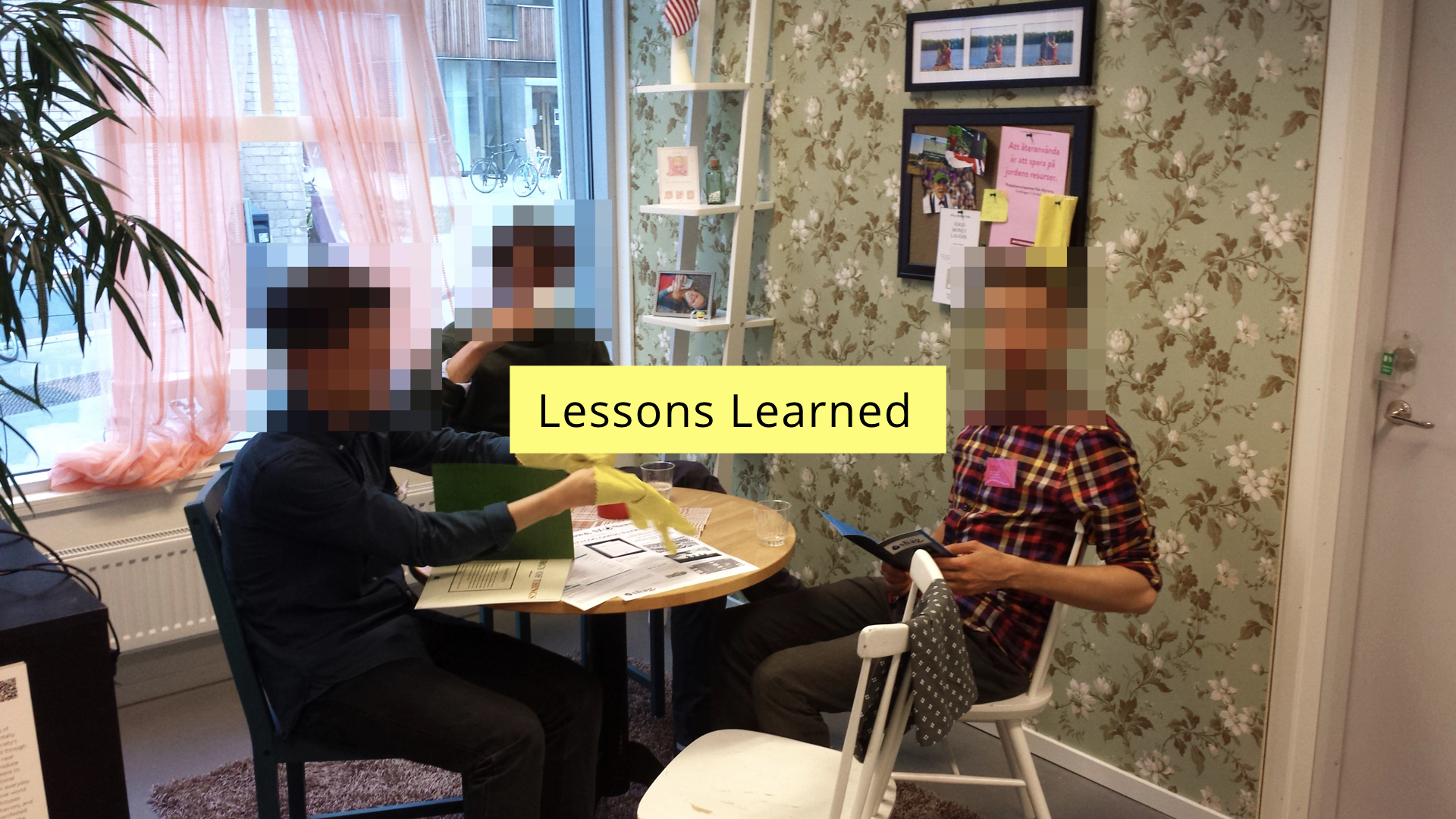
So how was this humor received and what did I learn from engaging with humor in design fiction? The three lessons learned that I’ll next present draw upon responses from design students involved in the production, design practitioners and researchers at the masters thesis examination, and industry professionals at exhibitions.

A core dilemma experienced throughout the production was not only how humor in the project would be received, but also how design students involved would be received. Overall, 16 interaction and industrial design students were involved in ideation and the production. As many were Master’s students aspiring to enter industry, there was a competing concern for personal and professional reputation versus the development of a design repertoire. This can be seen in an interview with the voice actress of the infomercial regarding her request to be anonymous: “I was uncomfortable with the idea of an audio clip of me credited with saying ‘vigorous hand jobs’ would live forever
on the internet.”
Yet she also expressed an interest in expanding a range of design methods aimed at critique: “I was curious to see in further detail how a project of that nature was different than a traditional one and what different kinds of questions it would bring up or different tools it would use.” Those tools, being innuendos to evoke laughter, highlight the importance of balancing an uncensored design space for an exploration of humor, with a consideration towards differing levels of engagement as the humor reflects beyond the design fiction.
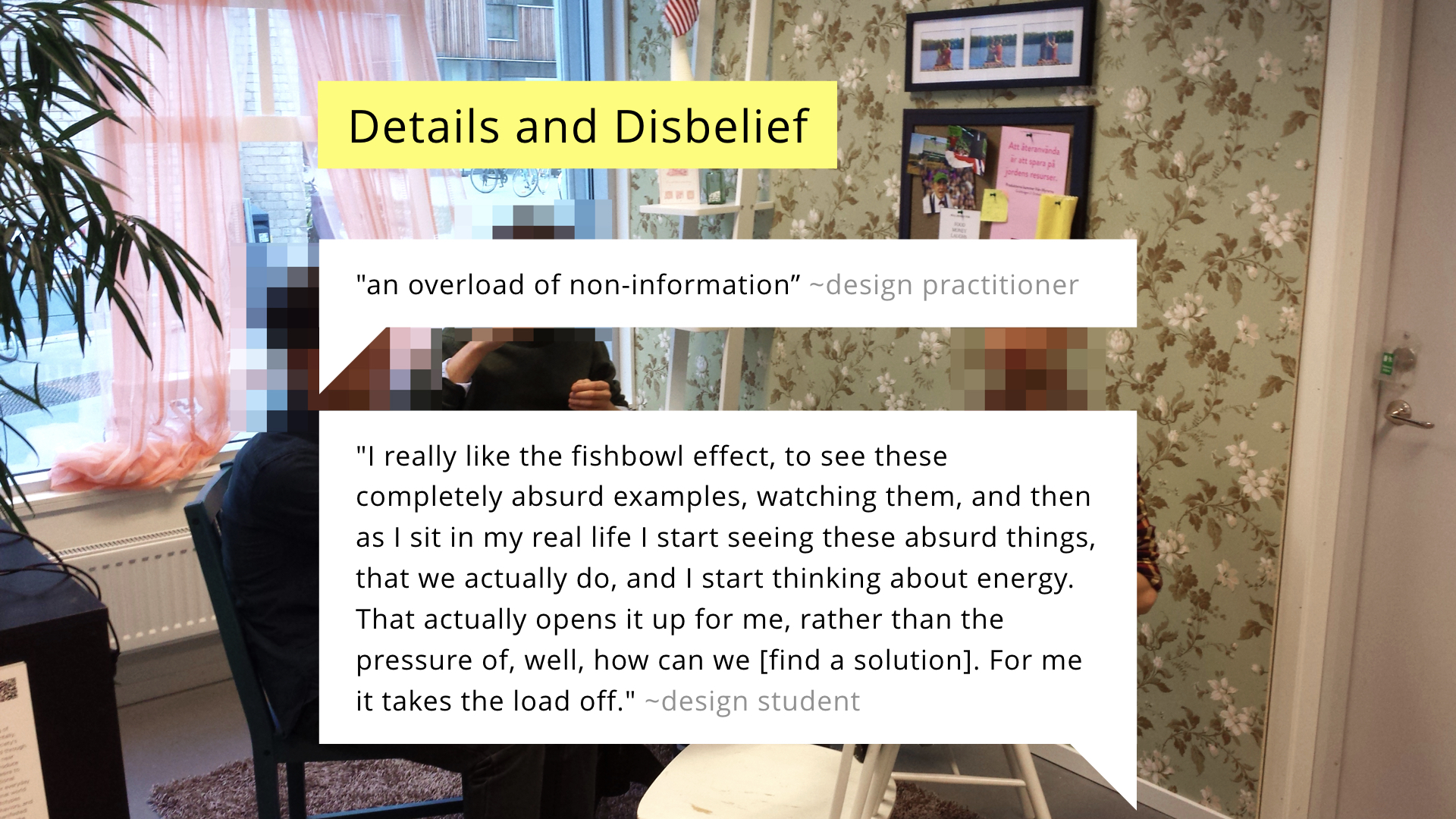
Without mediating the quantity of humor, a difficulty lay in balancing the details that contribute to the humor and narrative, versus alienating an audience. For example, a design practitioner during the examination found the design fiction inaccessible due to “an overload of non-information: while a design student at the examination appreciated a shift in accountability enabled by the exaggerated details. He said: “I really like the fishbowl effect, to see these completely absurd examples, watching them, and then as I sit in my real life I start seeing these absurd things, that we actually do, and I start thinking about energy. That actually opens it up for me, rather than the pressure of, well, how can we [find a solution]. For me it takes the load off.” Though different in effect and perhaps indicative of the flow of details to make the narrative relatable, both responses suggest a suspension of belief as the scenario is clearly not real.
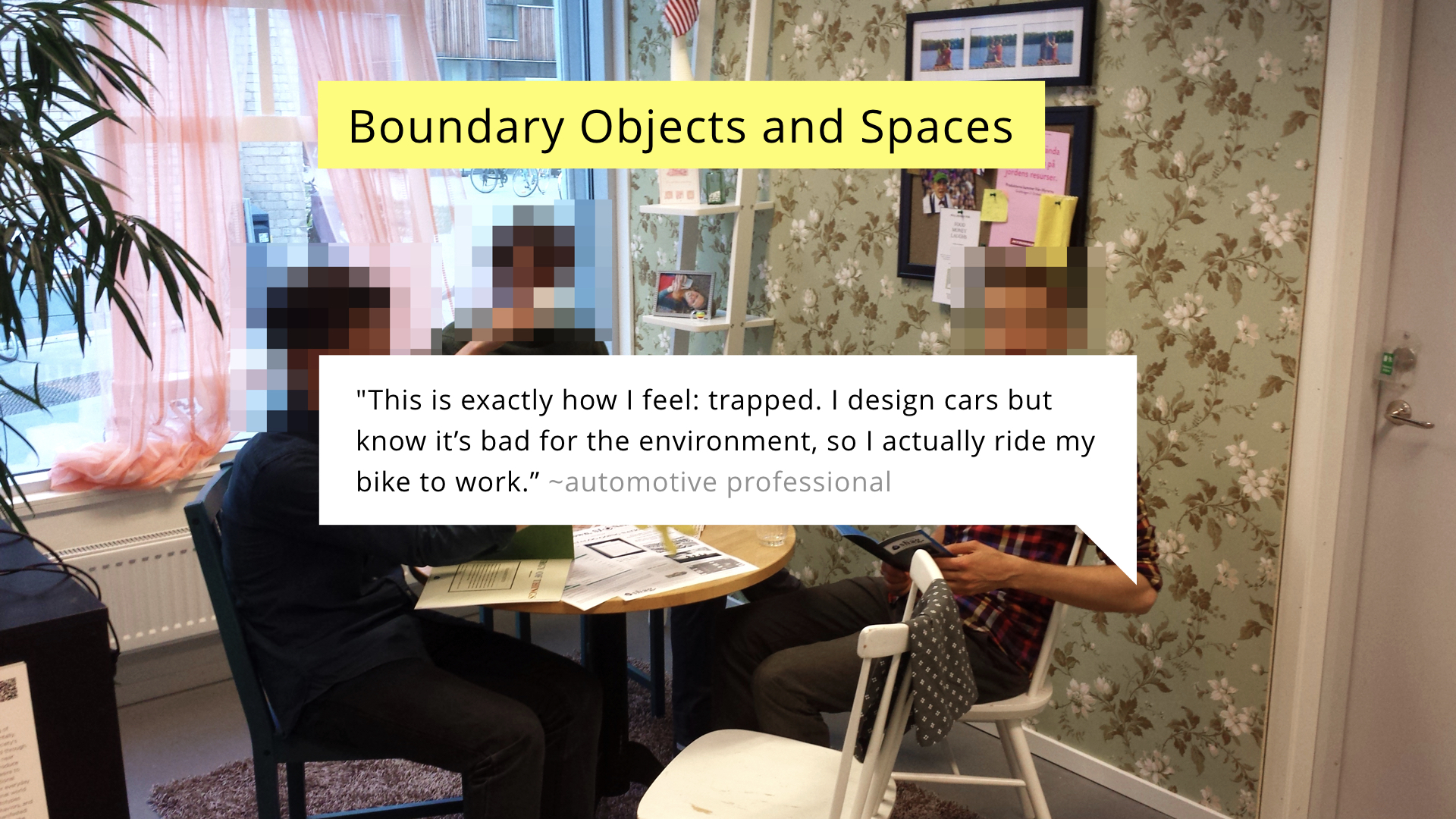
And lastly – the humor resulted in the emergence of unintentional boundary objects that aided reflection and discussion. For example, the exhibition space, designed as an ordinary room, also broke what is called the fourth wall, or theatrical boundary dividing the audience and actors (the fictional family). This inviting of the audience into the space was for comic relief from the dystopian elements in the narrative, but also resulted in an uncanny embedding of the radio show feature a family within the home of said family. An automotive professional at an exhibition appeared to express empathy for the family by remarking: “This is exactly how I feel: trapped. I design cars but know it’s bad for the environment, so I actually ride my bike to work.” This suggested the exhibition as a boundary space enabled by a “human-scale” design fiction in which the audience could literally step into the layered world.
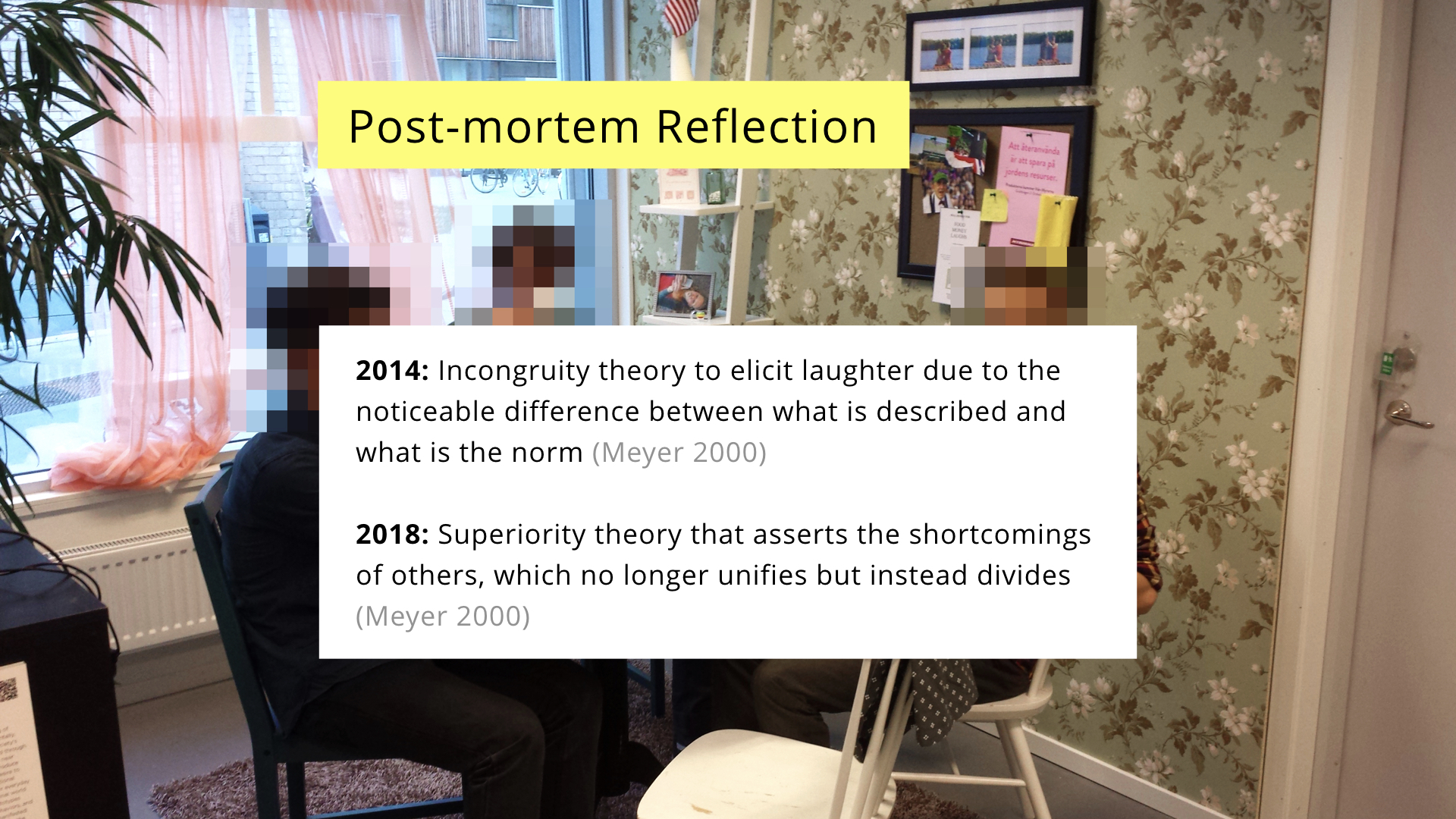
So, as the design fiction was created in 2014 but set in 2018, I just want to very briefly close with a post-mortem reflection on the floating nature of humor relative to contemporary political events.
While there is a long history of political satire that engages with humor in the delivery and analysis of news, the political humor used in this scenario, drew upon incongruity theory to elicit laughter due to the noticeable difference between what is described and what is the norm. For example, an attempt at humor could be found in the name Dick Tator – which I would propose was a nonthreatening joke that contrasted with then President Obama’s cool demeanor and promise of hope. And the intention was a unifying entertainment for discourse and a lightening of dark humor.
Following the 2016 elections with Donald Trump in office, many of the humorous elements have changed meanings. For example, the name Dick Tator might no longer be interpreted as incongruent, the Clean Party might have shifted from an environmental pun to contain racial undertones, and the American-made energy mandate might speak to nationalist policies. These interpretations result in a humor that no longer unifies but instead divides by taking an irreverent tone and position towards the President. Thus, while the scenario might still be considered funny, it is no longer through incongruity and instead through superiority, in which it asserts the shortcomings of others. This highlights additional challenges and opportunities for how academic design fictions, with and without humor, can be revisited and interpreted of over time.
